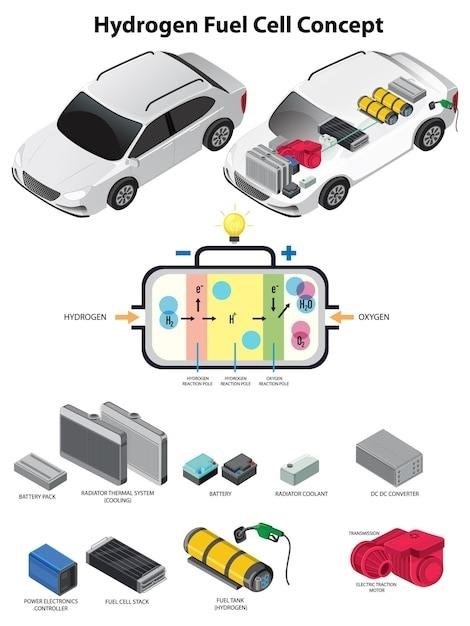
mercedes c300 fuse box diagram pdf
Mercedes C300 Fuse Box Locations
Your Mercedes C300 typically features multiple fuse boxes⁚ one in the engine compartment, another inside the car (usually under the dashboard), and potentially a third in the trunk․ Their exact locations vary slightly by model year․
Engine Compartment Fuse Box
The engine compartment fuse box in your Mercedes C300 is usually situated under the hood, often near the battery or on the inner fender․ Access it by carefully opening the hood and locating the clearly marked fuse box cover․ This box protects critical engine components and systems․ Always consult your owner’s manual or a reputable online resource like a Mercedes-Benz-specific forum for a diagram specific to your vehicle’s year and model․ Misplacing or incorrectly installing a fuse can lead to serious damage, so accurate identification is crucial․ Remember, fuses are color-coded for amperage; replacing a blown fuse with one of a different amperage might lead to further electrical problems․ Before working on the engine compartment fuse box, always ensure the vehicle’s ignition is off․ If you are uncomfortable working on your car’s electrical system, it’s best to seek assistance from a qualified mechanic․ Improper handling could cause damage to your vehicle’s electrical system․ The diagram will show you the location and purpose of each fuse․
Interior Fuse Box (Dashboard)
The interior fuse box, often located beneath the dashboard on the driver’s side, controls many of your Mercedes C300’s interior electrical components․ To access it, you might need to remove a trim panel or cover; consult your owner’s manual for precise instructions on accessing your specific model year․ The location might vary slightly depending on the year and trim level of your vehicle․ This fuse box protects circuits related to your power windows, lights, audio system, and other interior features․ Always use a fuse puller tool to remove fuses to prevent damage․ Never attempt to replace a fuse with one of a higher amperage; doing so could damage the circuit or even cause a fire․ Again, a diagram specific to your C300’s year is essential for accurate identification of fuses․ If you’re unsure about any fuse, it’s always best to consult a professional mechanic to avoid potential damage to your vehicle’s electrical system․ Incorrectly handling fuses can lead to unexpected electrical problems․ Before working, ensure the vehicle is turned off․
Trunk/Rear Fuse Box (if applicable)
Some Mercedes C300 models, particularly station wagons or those with extensive rear-seat entertainment systems, may have an additional fuse box located in the trunk or rear cargo area․ This less frequently accessed box typically protects circuits for rear lights, power outlets, and other features specific to the rear of the vehicle․ Accessing this box usually involves removing a panel or cover․ Always consult your owner’s manual for the precise location and access method for your specific C300 model and year․ Remember that this additional fuse box, if present, contains fuses different from those in the engine compartment or dashboard․ Using the correct diagram is crucial to avoid confusion and potential electrical damage․ Always use caution when working with electrical components, and if you are unsure about any aspect of fuse replacement, seek professional assistance․ Replacing the wrong fuse can lead to further electrical problems or damage to your vehicle’s systems․

Finding the Correct Diagram
Accurate fuse box diagrams are crucial for safe repairs․ Your C300’s year and model determine the correct diagram; use online resources or your owner’s manual․
Identifying Your Mercedes C300 Year
Precisely identifying your Mercedes C300’s year of manufacture is paramount to finding the correct fuse box diagram․ This information is typically found on a sticker located inside the driver’s side doorjamb, on the vehicle’s registration documents, or in your owner’s manual․ The year significantly impacts the fuse box layout and component assignments․ Variations exist between model years, even within the same C300 model․ Failure to correctly identify the year can lead to using an incorrect diagram, potentially resulting in incorrect fuse identification and unsafe repair attempts․ Double-check this crucial piece of information to ensure accuracy before proceeding with any fuse box related work․ Confirming the year is a simple yet vital first step in the process of locating the appropriate diagram for your specific vehicle․ This will prevent any potential complications or mistakes during the repair process․
Determining the Specific Fuse Box Diagram Based on Year and Model
Once you’ve confirmed your Mercedes C300’s year, the next step is to locate the precise fuse box diagram matching your specific model․ Remember that even within a single year, slight variations can occur depending on trim level and optional features․ Online resources often categorize diagrams by year and then offer further sub-categories for different models or options packages․ Pay close attention to these details․ Using an incorrect diagram can lead to misidentification of fuses and relays, potentially causing damage to your vehicle’s electrical system․ Thorough verification is crucial; a simple mistake could result in the replacement of a perfectly good fuse or, worse, the failure to identify the actual faulty component․ Take your time to ensure that the diagram you select perfectly aligns with your C300’s specifications to prevent future electrical problems․
Accessing Online Resources for Diagrams
Numerous online resources provide Mercedes C300 fuse box diagrams․ Websites specializing in automotive repair manuals often have downloadable PDFs, sometimes requiring a paid subscription․ YouTube channels dedicated to car maintenance may offer videos showing fuse box locations and diagrams․ Always verify the source’s reliability before using any diagram․ Look for reputable websites and channels with positive reviews and a history of accurate information․ Be cautious of unofficial sources, as incorrect diagrams can lead to misidentification of fuses and potentially damage your vehicle’s electrical system․ Remember to always cross-reference information from multiple sources whenever possible to ensure accuracy․ When in doubt, consulting a qualified Mercedes-Benz mechanic is recommended to avoid potential complications․

Understanding Fuse Box Diagrams
Mercedes C300 fuse box diagrams use symbols and labels to represent different circuits and fuses․ Amperage ratings are crucial for safe replacement․
Interpreting Symbols and Labels on the Diagram
Mercedes-Benz C300 fuse box diagrams employ standardized symbols․ Each symbol represents a specific electrical component, such as headlights, power windows, or the radio․ Labels often include component names and sometimes circuit numbers for easier identification․ Understanding these symbols is key to quickly locating the fuse responsible for a malfunctioning system․ For example, a symbol depicting a headlight might be labeled “Headlamp Left” or a similar designation․ Additionally, the diagram may use color-coding to further clarify circuit groupings or fuse types․ Referencing a legend or key within the diagram itself can resolve any ambiguity in symbol interpretation․ Always cross-reference the diagram with your vehicle’s specific year and model to ensure accuracy, as fuse box layouts can vary slightly across production years․
Locating Specific Fuses Based on Component
Once you’ve obtained the correct fuse box diagram for your Mercedes C300’s year and model, identifying the fuse for a particular component becomes straightforward․ The diagram will list each fuse’s position within the box, often using numbered slots or a grid system; Alongside each position, you’ll find a label or symbol indicating the component the fuse protects․ For instance, if your headlights aren’t working, locate the symbol or label representing the headlights (often “Headlamps”) on the diagram․ The corresponding number or position will direct you to the correct fuse within the physical fuse box․ Carefully check the diagram’s legend to decipher any unfamiliar symbols or abbreviations․ Remember that some diagrams may provide multiple views or sections, so ensure you’re consulting the correct section for the relevant fuse box location (engine bay, interior, or trunk)․
Fuse Amperage and Replacement
Your Mercedes C300’s fuse box diagram will specify the amperage rating for each fuse․ This rating indicates the maximum current the fuse can handle before it blows․ Never replace a blown fuse with one of a higher amperage rating; doing so could damage your vehicle’s electrical system․ Always use a fuse with the exact same amperage rating as the original․ When replacing a fuse, ensure the ignition is off to prevent electrical shocks․ Locate the blown fuse, and carefully remove it using the appropriate tool (often included with the vehicle or readily available at auto parts stores)․ Insert the new fuse, making sure it’s fully seated․ After replacement, test the affected component to confirm functionality․ If the fuse blows immediately after replacement, there’s likely an underlying electrical problem that needs professional attention․ Ignoring this could lead to further damage․ Consult your owner’s manual or a qualified mechanic․
Common Fuse Issues and Troubleshooting
Blown fuses often indicate an underlying electrical fault․ Safe replacement involves matching amperage and addressing root causes to avoid repeated failures․
Identifying Blown Fuses
Inspecting fuses for damage is crucial for effective troubleshooting․ A blown fuse will typically show a broken filament, appearing as a clear gap within the fuse’s metallic element․ Some fuses incorporate a visual indicator, such as a small window that turns black or changes color when the fuse blows․ This visual cue simplifies identification․ Carefully remove the suspect fuse and examine it closely, using a flashlight if necessary to see the internal filament clearly․ Remember to always use the correct tool to remove fuses, which are normally a small plastic puller or pliers designed to fit the fuse, as using the wrong tool can damage the fuse box․ If you’re unsure, consult your Mercedes-Benz owner’s manual for specific instructions․ Do not attempt to test fuses with a multimeter or other electrical testing equipment without proper training, as this is dangerous․ If a fuse is found to be blown, it’s essential to determine the cause before replacing it with a new one of the same amperage rating; otherwise, you may be replacing fuses repeatedly due to an underlying electrical problem․
Safe Fuse Replacement Procedures
Replacing a blown fuse requires careful attention to safety and correct procedure․ Always turn off the related electrical system or the entire vehicle before attempting any fuse replacement․ This prevents electrical shocks and further damage․ Locate the appropriate fuse using your Mercedes C300’s fuse box diagram․ Use a fuse puller or appropriate pliers to carefully remove the blown fuse, avoiding damage to the fuse holder․ Never use a higher amperage fuse as a replacement; this can lead to overheating and potentially more serious electrical problems․ Always replace the blown fuse with a new one of the exact same amperage rating․ After inserting the new fuse, double-check its proper seating in the holder․ Turn the electrical system back on and test the functionality of the affected component․ If the fuse blows again immediately, there’s likely a more significant electrical problem requiring professional attention from a qualified mechanic․ Do not repeatedly replace the fuse without investigating the root cause․
Addressing Underlying Electrical Problems
If a fuse keeps blowing, despite replacement with a correctly rated fuse, there’s a more serious underlying electrical issue within the affected circuit․ This shouldn’t be ignored; continued use could damage components or even create a fire hazard․ The problem might stem from a short circuit somewhere in the wiring, a faulty electrical component (like a malfunctioning headlight or power window motor), or a more complex electrical fault within the vehicle’s system․ Attempting repairs without proper training and tools could worsen the situation․ It’s crucial to consult a qualified Mercedes-Benz mechanic or an experienced auto electrician․ They possess the diagnostic equipment and expertise to pinpoint the root cause, safely repair the fault, and ensure your vehicle’s electrical system operates correctly and safely․ Ignoring recurring blown fuses can lead to far more expensive repairs later․






